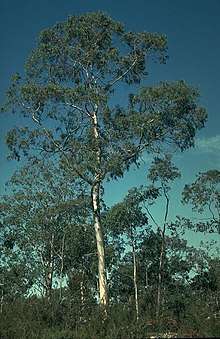Eucalyptus tenuiramis
Eucalyptus tenuiramis, commonly known as the silver peppermint,[2] is a species of small to medium-sized tree that is endemic to southeastern Tasmania. It has smooth bark, broadly lance-shaped adult leaves, flower buds in groups of nine to fifteen, white flowers and cup-shaped, hemispherical or conical fruit.
| Silver peppermint | |
|---|---|
 | |
| Scientific classification | |
| Kingdom: | Plantae |
| Clade: | Tracheophytes |
| Clade: | Angiosperms |
| Clade: | Eudicots |
| Clade: | Rosids |
| Order: | Myrtales |
| Family: | Myrtaceae |
| Genus: | Eucalyptus |
| Species: | E. tenuiramis |
| Binomial name | |
| Eucalyptus tenuiramis | |
Description
Eucalyptus tenuiramis is a tree that typically grows to a height of 25 m (82 ft) and forms a lignotuber. It has smooth white to grey or yellowish bark. Young plants and coppice regrowth have sessile, egg-shaped leaves that are 17–60 mm (0.67–2.36 in) long, 10–38 mm (0.39–1.50 in) wide and arranged in opposite pairs. Adult leaves are broadly lance-shaped to elliptical, 55–130 mm (2.2–5.1 in) long and 10–25 mm (0.39–0.98 in) wide, tapering to a petiole 7–12 mm (0.28–0.47 in) long. The flower buds are arranged in leaf axils in groups of nine to fifteen on an unbranched peduncle 4–12 mm (0.16–0.47 in) long, the individual buds on pedicels 1–4 mm (0.039–0.157 in) long. Mature buds are oval to club-shaped, 5–8 mm (0.20–0.31 in) long and 3–4 mm (0.12–0.16 in) wide with a conical or rounded operculum. Flowering occurs from November to February and the flowers are white. The fruit is a woody cup-shaped, hemispherical or conical capsule 5–12 mm (0.20–0.47 in) long and 6–11 mm (0.24–0.43 in) wide with the valves near rim level.[2][3][4]
Taxonomy and naming
Eucalyptus tenuiramis was first formally described in 1856 by Friedrich Anton Wilhelm Miquel in the journal Nederlandsch Kruidkundig Archief.[5][6] The specific epithet (tenuiramis) is from the Latin tenui- meaning "slender" or "thin" and ramus meaning "branch".[2]
This eucalypt is reported as being an older form of its sister species, E. risdonii.[7]
Distribution and habitat
Silver peppermint grows in open forest, often in pure stands, on lowlands and hills in south-eastern Tasmania especially in the Derwent River valley, but also on the Freycinet Peninsula and on Flinders Island.[2][3]
References
- "Eucalyptus tenuiramis". Australian Plant Census. Retrieved 6 January 2020.
- "Eucalyptus tenuiramis". Euclid: Centre for Australian National Biodiversity Research. Retrieved 28 May 2020.
- Chippendale, George M. "Eucalyptus tenuiramis". Australian Biological Resources Study, Department of the Environment and Energy, Canberra. Retrieved 6 January 2020.
- Jordan, Greg. "Eucalyptus tenuiramis". University of Tasmania. Retrieved 6 January 2020.
- "Eucalyptus tenuiramis". APNI. Retrieved 6 January 2020.
- Miquel, Friedrich A.W. (1856). "Stirpes Novo-Hollandas a Ferd Mullero collectas determinavit". Nederlandsch Kruidkundig Archief. 4 (1): 128–129. Retrieved 6 January 2020.
- R. J. E. Wiltshire; J. B. Reid & B. M. Potts (1998). "Genetic Control of Reproductive and Vegetative Phase Change in the Eucalyptus risdonii–E. tenuiramis Complex". Australian Journal of Botany hosted at Commonwealth Scientific and Industrial Research Organisation. Retrieved 27 March 2010.
External links
| Wikimedia Commons has media related to Eucalyptus tenuiramis. |